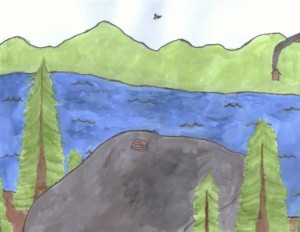“…in her mind she was experiencing things that were stronger and more meaningful than the things she could experience with the rest of us… ‘right now you’re the hardest person for her to see. You’re the one who upsets her most. Because you’re the most real, and you make her lose balance.’”
“One day she had walked out and not come back. Her clothes had been found on a rocky bluff overlooking the Hudson, neatly folded in a pile… It was a beautiful spot to commit suicide, perhaps to run out from between the snow-dusted conifers, to push off from the granite and sail through the air, gazing across the far bank of the mighty river, where a small house exhaled smoke from its chimney, before crashing into the icy current below… I thought of Erica removing her clothes and then, having shed her past, walking through the forest until she met a kindly woman who took her in and fed her.”
“One evening I was walking with Erica through Union Square and we saw a firefly. ‘Look!’ She said, amazed. ‘It’s trying to compete with the buildings… We watched as it crossed Fourteenth Street, headed south…’Do you think he made it?’ She asked me. ‘I have no idea,’ I said, ‘But I hope so.’”
– Mohsin Hamid, The Reluctant Fundamentalist
While reading The Reluctant Fundamentalist I had a hard time connecting it with what we’ve learned in this class. While it obviously touches on issues of how Muslims and people from the Middle East and South Asia are treated in post-September 11th America, very little was said about Islam. Because of this I spent some time looking into any characters or scenes that could be viewed as symbolic of Islamic beliefs or practices. I found that, whether it was intentional by the author or not, there were some parallels between Erica’s experience and some of the Sufi beliefs we talked about in class.
Erica’s love for Chris, despite his lack of physical presence in her life, is made out to be stronger and more meaningful to her than anything else in the world. In comparison, everything else isn’t real, although her (lesser) love for Changez is apparently the only thing that comes close. This directly parallels our discussions of Sufism and the ultimate goal of experiencing the love of God (which was also a part of other Muslim traditions besides just Sufism) as the most important endeavor in ones life. It also brings up the metaphor we discussed in which you must turn away from a beautiful bride, who is meant to represent the physical world, since she is fleeting and ultimately turns into an ugly old woman. This metaphor reflects the idea that attachment to this world is futile, as ultimately nothing physical is real and only love for God will remain in the end. The same quote also brings up the Sufi idea that you can come close to experiencing God’s love here on earth, as Erica seems to do through her love of Changez (but in the end, it’s only a distraction from her higher love for Chris).
The idea that Erica’s love and suicide are meant to symbolize love for God is further supported by the fact that a chunk of the story takes place in Pakistan, where Bulleh Shah, who claimed that the human soul is a woman yearning for the eternal beloved, was from. Also, the way in which Changez describes Erica’s removal of her clothes as a means of shedding her past reflects the Sufi idea that you need to shed your nafs (ego) in order to truly experience God. Changez’s hope that Erica survived and was took in and fed could be seen as an insistence that death is not the end, but that God takes care of his followers in heaven.
Because Erica’s death was not only a very dramatic part of the novel, but also seemed to have religious undertones relating to what we’ve talked about in this class, I decided to make a water color painting of the scene of her suicide. I painted the rock, the river, the trees (I couldn’t figure out how to do snow with watercolors, so I ignored that part), the house in the distance, and the neatly stacked pile of clothes. I also painted a firefly flying up above where Erica jumped to symbolize her desire to escape this world (potentially an escape into God’s love), just as the firefly who was crowded out by all the lights of the city needed to find an escape, as well as to symbolize Changez’s hope that she succeeded in doing so.
